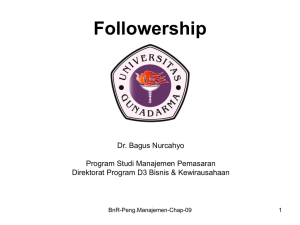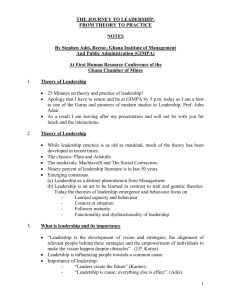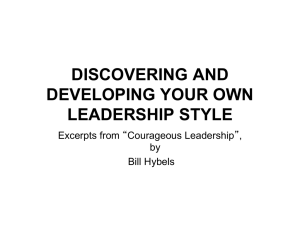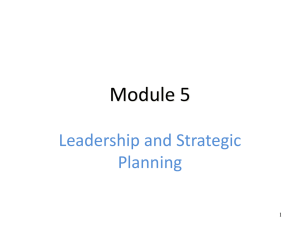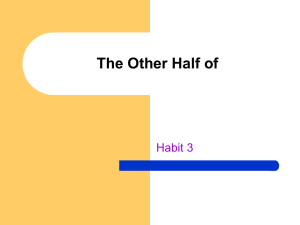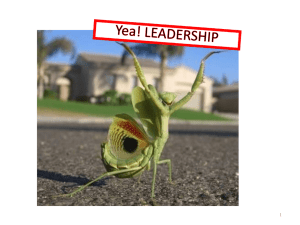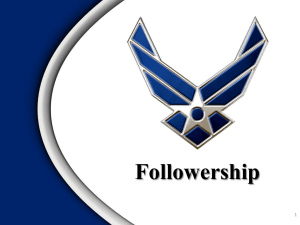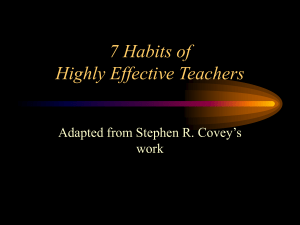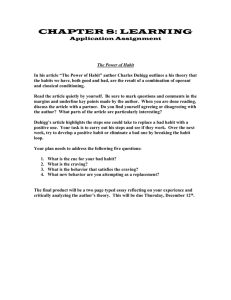Followership - SUNY Maritime College
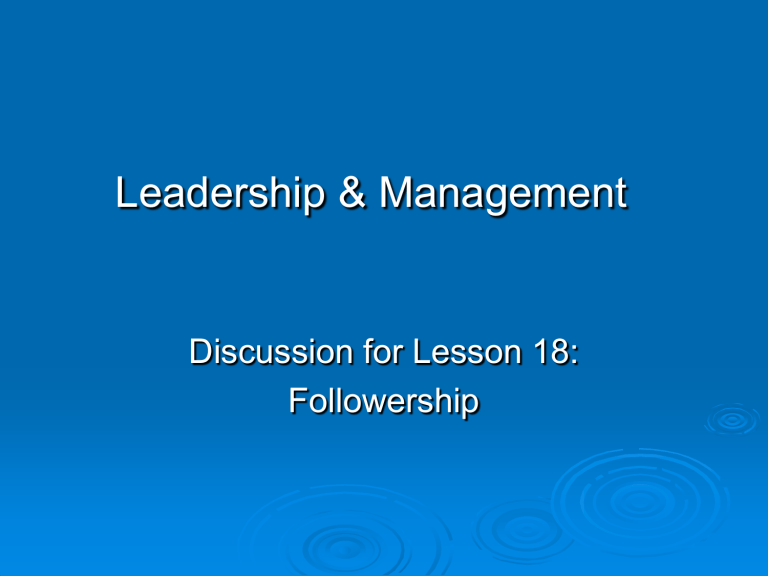
Leadership & Management
Discussion for Lesson 18:
Followership
Lesson 18
Reading Objectives
1. The student will comprehend their followership style and take steps to become a more effective follower.
2. The student will comprehend and apply the principles of courageous followership, including responsibility, service, challenging authority, participating in change and knowing when to leave.
3. The student will comprehend developing personal potential to include the Seven Habits of Highly
Effective People.
Lesson 18
Discussion Objectives
1. The student will apply the principles of courageous followership, including responsibility, service, challenging authority, participate in change and knowing when to leave.
2. The student will comprehend developing personal potential to include the Seven Habits of Highly Effective People.
The Courageous Follower
Courage is found in both effective leaders and followers:
Willingness to take risks, challenge authority and to believe one’s own ideas are superior typically marks a follower as a future leader.
Follower role includes responsibility, service, challenging authority, participating in change and knowing when its time to leave organization.
These components of followership require courage.
Role of the Follower
Leadership and followership are fundamental roles that individuals shift in and out of under various conditions.
Followers’ influence upon a leader can enhance or underscore shortcomings in the leader.
Many qualities desirable in a leader are the same qualities possessed by an effective follower.
Role of the Follower (Cont.)
Courage to assume responsibility
Courageous followers:
• Do not presume that a leader or an organization will provide them with security, permission to act or personal growth.
• Initiate opportunities for personal fulfillment, growth and the fullest use of their capabilities.
Role of the Follower (Cont.)
Courage to serve
Courageous followers:
• Discern the needs of the organization and actively seek to serve those needs.
• Support the leader’s decision, providing strength, complementing the leader’s position and serving others’ display of follower’s courage.
Role of the Follower (Cont.)
Courage to challenge
Courageous followers:
• Do not sacrifice the purpose of the organization or their personal ethics in order to maintain harmony and minimize conflict.
• They stand up against leaders and decisions when that behavior contradicts the best interest of the organization or their own integrity.
Role of the Follower (Cont.)
Courage to participate in transformation
Courageous followers:
• View the struggle of corporate change and transformation as a mutual experience.
• Support the leader and the organization during a difficult transformation.
• Are not afraid to confront change and work toward reshaping the organization.
Role of the Follower (Cont.)
Courage to leave
Often organizational change creates a situation in which a follower must withdraw from a leader-follower relationship.
Followers are not afraid to depart because they do not rely on leaders or organizations for their self-worth.
Styles of Followership
Robert E. Kelley described five styles of followership categorized according to two dimensions:
The first dimension is the quality of independent, critical thinking, versus dependent, uncritical thinking:
• A dependent, uncritical thinker does not consider possibilities, does not contribute to the cultivation of the organization and accepts the leader’s ideas without thinking.
Styles of Followership (Cont.)
The second dimension is active versus passive behavior:
An active individual participates fully in the organization.
A passive individual is characterized by a need for constant supervision.
Styles of Followership (Cont.)
Dimensions result in five Followership styles:
Alienated Follower: Passive yet independent, critical thinker.
Conformist: Active participant who does not utilize critical thinking skills.
Pragmatic Survivor: Has qualities of all four extremes, depending upon which fits situation.
Passive Follower: Exhibits neither critical, independent thinking nor active participation.
Effective Follower: Critical, independent thinker and active in the organization. Future leader.
Sources of Follower Courage
The courage to accept risk derives from several sources:
Strength from personal philosophy/religious beliefs.
A vision of the future can provide courage to follow difficult course of action.
Past event that tested individual courage can make future courageous behavior easier.
Personal values can give one the courage to act.
Commitment to peers, deep concern for others and outrage toward injustice can foster change.
Developing Personal Potential
Steven Covey defines a habit as the intersection of knowledge, skill and desire.
He arranges seven habits along a continuum from dependence to interdependence.
Developing Personal Potential
(Cont.)
Each habit builds on the previous one so individuals grow further along the maturity continuum as they develop personal effectiveness habits:
Dependent people expect someone to take care of them and blame others when things go wrong.
Independent people have developed a sense of selfworth and an attitude of self-reliance.
Interdependent people realize that it is best to work cooperatively with others.
Developing Personal Potential
(Cont.)
Covey’s first three habits deal with selfreliance and self-mastery. These are private victories; they only involve the follower:
Habit 1: Be Proactive ®
• Be responsible, don’t blame others.
Habit 2: Begin With The End In Mind ®
• Start with a clear mental image of your destination.
Habit 3: Put First Things First ®
• Focus on preserving and enhancing relationships and on accomplishing results.
Effective Interdependence
The first three habits build a foundation on independence, from which one can move to interdependence —caring, productive relationships with others which Covey calls public victories.
When a person moves to interdependence, s/he assumes a leadership role.
Effective Interdependence (Cont.)
Habit 4: Think Win-Win ®
• Implies understanding that without cooperation, the organization cannot succeed.
Habit 5: Seek First To Understand, Then To Be
Understood ®
• Requires a nonjudgmental attitude. Emphatic listening gets inside another person’s frame of reference.
Effective Interdependence (Cont.)
Habit 6: Synergize ®
• Synergy is the combined action that occurs when people work together to create new alternatives and solutions. The essence of synergy is to value and respect differences.
Habit 7: Sharpen The Saw®
• Process of using and continuously renewing the physical, mental, spiritual and social aspects of life.
Next Class
Groups and Teams
Read: Leadership & Management,
Chapter 19
Summary
Follower role includes responsibility, service, challenging authority, participating in change and knowing when its time to leave organization.
Developing Personal Potential:
Covey defines a habit as the intersection of knowledge, skill and desire.
He arranges seven habits along a continuum from dependence to interdependence.
When a person moves to interdependence, s/he assumes a leadership role.
Summary (Cont.)
Habit 1: Be Proactive ®
Habit 2: Begin With The End In Mind ®
Habit 3: Put First Things First ®
Habit 4: Think Win-Win ®
Habit 5: Seek First To Understand, Then To Be
Understood ®
Habit 6: Synergize ®
Habit 7: Sharpen The Saw®
Questions?
???
